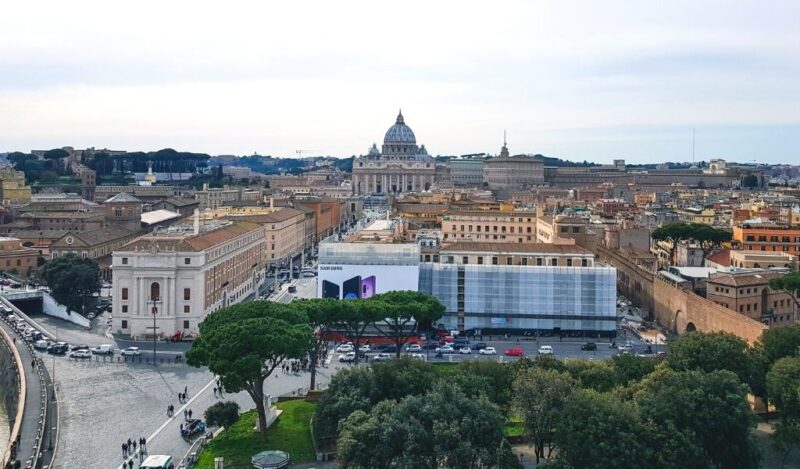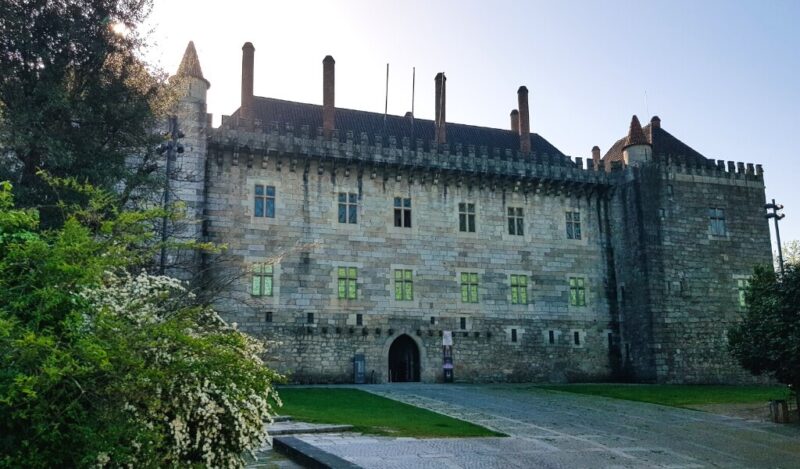Saint Peter’s Basilica (in Latin, Basilica Sancti Petri; in Italian, Basilica di San Pietro) is the largest and most important church in the Catholic religion. Located in Vatican City State (also known as the Holy See, since it’s the seat of the Catholic Church), it’s one of the main pilgrimage centers in the world.
Besides, it was built between the 16th and 17th centuries in the monumental Saint Peter’s Square and had the collaboration of some of the most renowned artists of the Renaissance and Baroque, such as Donato Bramante, Michelangelo Buonarroti, Raffaello Sanzio, and Gian Lorenzo Bernini.
So, do you want to know How To Visit Saint Peter’s Basilica In 2024? Keep reading!
This post may contain affiliate links, meaning I earn a small commission if you make a purchase, at no additional cost to you. Please read my disclosure & privacy policy for more information.
No time to read now? Pin it for later!


- Brief History of Saint Peter's Basilica
- Visiting Saint Peter's Basilica
- Façade of Saint Peter's Basilica
- Portico (or Atrium) of Saint Peter's Basilica
- Chapel of the Pietà
- Papal Altar & Saint Peter's Baldachin
- More Posts about the Vatican City
- More Posts about Religious Temples
- More Posts about World Heritage
- What Photography Gear Do I Use?
Brief History of Saint Peter’s Basilica
The origin of Saint Peter’s Basilica dates back to approximately 64 AD, with the crucifixion of St. Peter (one of the apostles of Jesus Christ) in the Circus of Nero – a circus from Ancient Rome located in the place where Vatican City now stands.
The martyr was buried on Vatican Hill and his tomb motivated the construction of a sanctuary in the fourth century, under the orders of the Roman Emperor Constantine I. Unfortunately, little remains of this first church, because the current Saint Peter’s Basilica was built on top of the paleochristian temple.
In the 15th century, the Old Saint Peter’s Basilica was already very deteriorated and in need of extensive intervention work. This began in the 1450s during the pontificate of Pope Nicolas V e and was carried out by the architects Leon Battista Alberti and Bernardo Rossellino.

However, the construction of the new Saint Peter’s Basilica itself only started in 1506, with Pope Julius II. The early church was demolished and Donato Bramante was commissioned to design a new building. But the works were only completed in 1626, almost 400 years later and after more than 20 papacies!
With the rise of artistic and philosophical ideals of the Renaissance, Saint Peter’s Basilica became one of the architectural symbols of this stylistic period. During its construction, Bramante was also succeeded by Rafaello Sanzio and Michelangelo Buonarroti, among other artists.
With the turn of the century and the transition to Baroque, this new style began to be incorporated, highlighting the façade by Carlo Moderno and the Saint Peter’s Square, by Gian Lorenzo Bernini. Due to its historical, cultural, and spiritual importance, Vatican City was inscribed as a UNESCO World Heritage Site in 1984.
World Heritage
Did you know that Saint Peter’s Basilica (in Vatican City) was part of Vatican City‘s second set of inscriptions on the UNESCO World Heritage List? This 8th session of the World Heritage Committee took place in Buenos Aires (Argentina), between October 29th and November 2nd, 1984.
Nowadays, Vatican City is the fortieth country in Europe and the one-hundred-seventh country in the world with the most UNESCO sites, tied with other twenty-five countries. It has two cultural heritage assets inscribed on the world list of the United Nations Educational, Scientific, and Cultural Organization!
Visiting Saint Peter’s Basilica
Located in the heart of Vatican City, Saint Peter’s Basilica offers easy access for all its pilgrims and visitors. If you want to travel by metro, just get off at Ottaviano station (line A) – which is 550 meters from the Vatican Museums and 850 meters from Saint Peter’s Basilica.
If you prefer to walk, I recommend crossing the Tiber River via Ponte Sant’Angelo or Ponte Vittorio Emanuele II. I think it’s very worthwhile to do the entire journey on foot instead of taking the metro: after all, Rome is a real “open-air museum”!
Another important tip is about the strict dress code of Saint Peter’s Basilica. It’s forbidden to enter the temple with bare shoulders, cleavages, or above-the-knee clothing (shorts, skirts, dresses, etc.). These rules apply to both men and women, regardless of the time of year – that is, even in summer!
Practical Information
Saint Peter’s Basilica is open every day of the year, from 7 am to 7 pm (April to September) or from 7 am to 6:30 pm (October to March). Nonetheless, it closes for tourist visits during papal celebrations and other types of events – including the Pope’s General Audiences on Wednesday mornings. As for the admission, it’s free.
Façade of Saint Peter’s Basilica
As I mentioned earlier, the Façade of Saint Peter’s Basilica was projected by Carlo Maderno, between 1607 and 1614. At almost 115 meters wide and 48 meters wide, it’s composed of a series of colossal columns (in this case, of two floors).
On the upper floor and above the main door, stands the famous Loggia delle Benedizioni, the balcony where the Pope speaks to the faithful after being elected and where he gives the Urbi et Orbi blessing at Easter and Christmas. And underneath the counter is a bas-relief by Ambrogio Buonvicino entitled “La consegna delle Chiavi a Pietro”.

On the balustrade that crowns the top, thirteen biblical statues almost six meters high were placed: Jesus Christ (in the center) and the apostles (except for Saint Peter, who has a neoclassical statue in front of the façade, sculpted by Giuseppe de Fabris in 1847).
Finally, it’s important to highlight the two clocks made by Giuseppe Valadier in 1785, also in neoclassical style. Each was placed on top of the bell tower to reinforce the perfect symmetry of the main Façade of Saint Peter’s Basilica.
Portico (or Atrium) of Saint Peter’s Basilica
The Portico (or Atrium) of Saint Peter’s Basilica leads pilgrims and visitors arriving from Saint Peter’s Square to the five great entrance doors: Porta della Morte, Porta del Bene e del Male, Porta de Filarete (or Porta Centrale), Porta dei Sacramenti, and Porta Santa (which is only open on Jubilees or Holy Years).
Like the Façade, the Portico was designed by Carlo Maderno in the early 18th century and is adorned with statues, reliefs, mosaics, and coats of arms. These decorative elements are divided between re-creations of episodes from the life of Saint Peter and representations of former Popes, many of them sanctified.
Chapel of the Pietà
Did you know that inside Saint Peter’s Basilica there are 45 chapels and 11 altars? And one of them is the Chapel of the Pietà (in Italian, Cappella della Pietà), the first one just to the right of the entrance through the Porta Santa.
The chapel is named after the magnificent work carved by Michelangelo Buonarroti when he was just 24 years old! The statue is made of Carrara marble and represents the Virgin Mary holding the body of Jesus Christ after the Crucifixion.

Today, Michelangelo’s “Pietà” remains one of the most famous sculptures in the world and is probably the most visited, especially when it comes to religious works.
Papal Altar & Saint Peter’s Baldachin
The Papal Altar of Saint Peter’s Basilica was erected above Saint Peter’s Tomb – the origin of the construction of this basilica itself.
As you would expect, the Papal Altar is located in the heart of Saint Peter’s Basilica and has been embellished by one of the most impressive structures in the temple: Saint Peter’s Baldachin.

This magnificent work in bronze and gold was conceived by Gian Lorenzo Bernini between 1624 and 1633 and is a clear example of the exuberance of the Baroque period.
It’s made up of four large Solomonic columns on marble pedestals and a richly decorated crown, which ends in a cross almost 30 meters high!
Share this blog post on your social media!
More Posts about the Vatican City
1 Day In Vatican City: The Perfect Vatican City Itinerary
How To Visit Saint Peter’s Basilica In 2024
Vatican Museums: Best Tips For Visiting In 2024
More Posts about Religious Temples
Jewish Museum Of Prague: Best Tips For Visiting In 2024
4 Best Monasteries In Portugal (That You Should Visit This Year)
How To Visit The Sanctuary Of Sameiro In 2024
More Posts about World Heritage
Palace Of The Dukes Of Braganza: Best Tips For Visiting In 2024
World Heritage In Castile And León (2024)
Machado De Castro National Museum: Best Tips For Visiting In 2024
What Photography Gear Do I Use?
- Camera Body: Fujifilm X-T4 Mirrorless
- Camera Lens: Fujinon XF 18-55 mm F2.8-4 R LM OIS
- Tripod: Manfrotto Compact Action
- Small Tripod: Manfrotto PIXI Mini
- Smartphone Adaptor: Manfrotto PIXI Clamp
- Memory Card: SanDisk 128GB Extreme PRO SDXC
This blog post uses stock photographs (Getty Images)









